The Mottled Owl (Ciccaba virgata) emerges as a captivating nocturnal enigma in the realms of Central and South American forests.
Characterized by its mesmerizing cryptic plumage, this medium-sized owl belongs to the Strigidae family, showcasing distinctive adaptations for a secretive and elusive lifestyle.
With a range extending from Mexico to Bolivia, the Mottled Owl thrives in diverse habitats, including tropical rainforests and montane cloud forests.
Its name alludes to the intricate patterns of rich chocolate-brown, white, and buff spots that adorn its feathers, providing effective camouflage.
Beyond its visual allure, the Mottled Owl boasts unique vocalizations, employing hoots and whistles to communicate in the dark.
From its nesting behaviors to its crucial role in nocturnal ecosystems, the Mottled Owl invites exploration into the mysteries of its life history, embodying the essence of avian fascination in the heart of the Americas. Stay sharp.
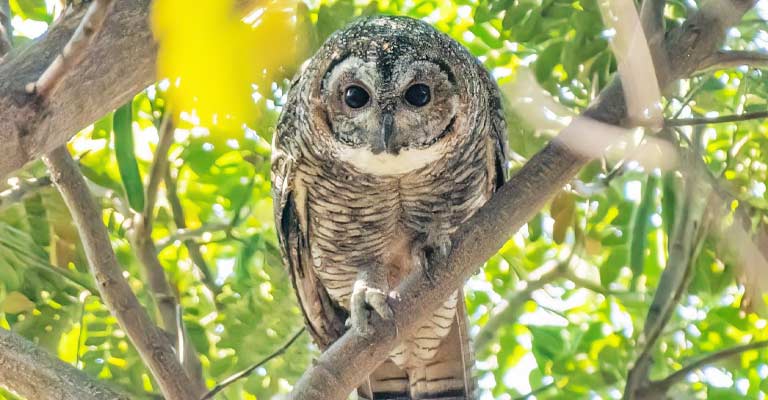
Identifying Characteristics of Mottled Owl
The Mottled Owl (Ciccaba virgata) is a captivating nocturnal bird species found in various parts of Central and South America.
Identifying this owl requires a keen eye and an understanding of its distinctive characteristics. Here are eight key points to help in the identification of the Mottled Owl:
Size and Shape
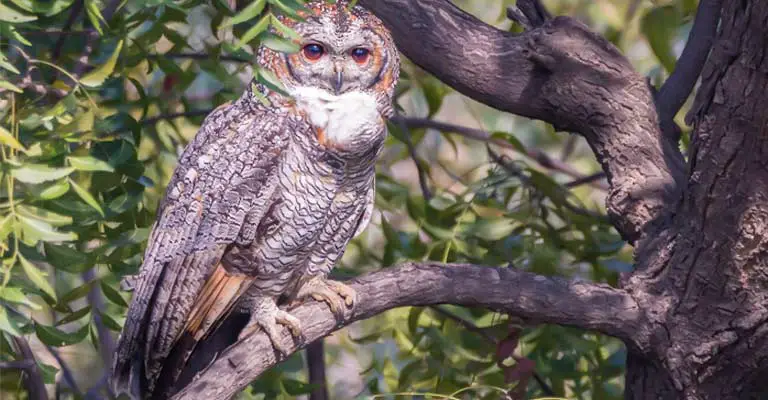
The Mottled Owl is a medium-sized owl with a robust and compact body. It typically measures between 14 to 16 inches in length, making it smaller than some of its owl relatives.
Its short tail and large, rounded head contribute to its distinct silhouette.
Coloration
The owl’s name derives from its intricate and mottled plumage. The upper parts are a rich, chocolate-brown color, adorned with intricate patterns of white and buff spots.
The facial disc, a defining feature of owls, is pale and showcases a dark border, emphasizing its facial features.
Facial Features
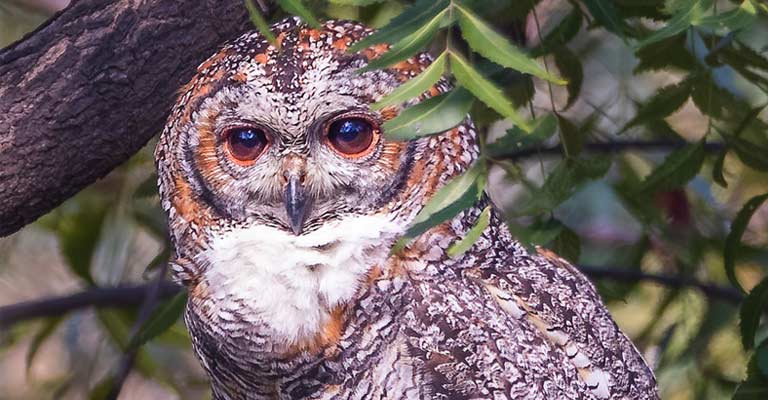
The facial disc of the Mottled Owl is characterized by a dark border that outlines the heart-shaped facial pattern. Dark eyes are set within the disc, giving the owl an intense and focused expression.
The facial disk aids in sound localization, helping the owl in hunting and navigating its surroundings.
Ear Tufts
Unlike some other owl species, the Mottled Owl lacks prominent ear tufts. Instead, it has inconspicuous feather tufts on the top of its head, which are often difficult to discern, especially when the owl is at rest.
Habitat
Mottled Owls inhabit a variety of forested environments, including tropical rainforests, montane cloud forests, and wooded areas.
They are adaptable and can be found in both lowland and mountainous regions, making their identification possible across a range of ecosystems.
Call and Vocalization
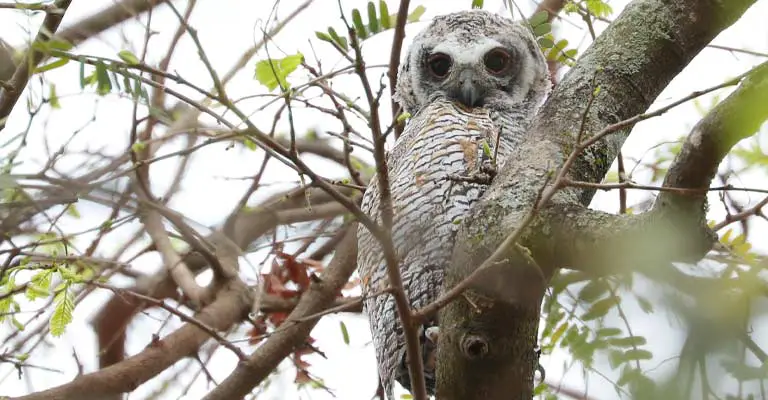
Mottled Owls are known for their distinct vocalizations. Their calls consist of a series of hoots and whistles, creating a unique pattern that aids in their identification, especially during the breeding season when their calls become more frequent.
Behavior
Observing the behavior of the Mottled Owl can also aid in identification. These owls are primarily nocturnal, hunting during the night and roosting during the day.
Their behavior includes perching in concealed locations and silently gliding through the forest canopy in search of prey.
Range
The Mottled Owl has a broad distribution, ranging from Mexico to western Panama.
Understanding their geographical distribution is crucial for identification, as it helps narrow down the possibilities when birdwatching in specific regions.
Recognizing the Mottled Owl involves a combination of visual and auditory cues, and understanding its unique coloration, facial features, habitat preferences, and behavior.
Birdwatchers and enthusiasts can enhance their ability to identify this captivating owl by paying attention to these key characteristics.
Taxonomy of Mottled Owl
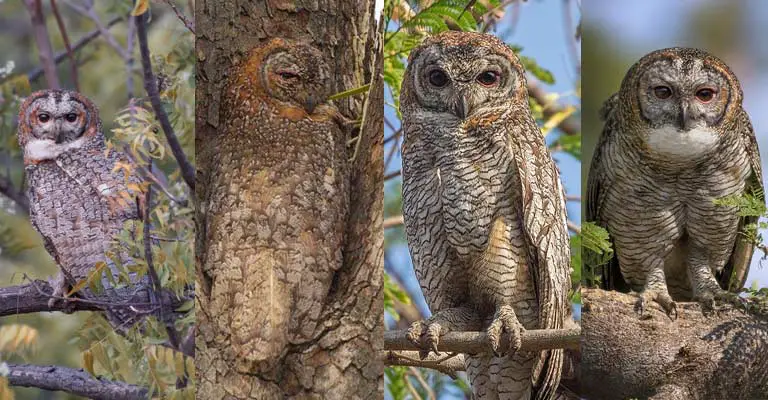
Here’s a table summarizing the taxonomy details of the Mottled Owl:
| Taxonomic Rank | Classification |
| Domain | Eukaryota |
| Kingdom | Animalia |
| Phylum | Chordata |
| Class | Aves |
| Order | Strigiformes |
| Family | Strigidae |
| Genus | Strix |
| Species | S. virgata |
The Mottled Owl (Ciccaba virgata) belongs to the Strigidae family within the order Strigiformes.
This nocturnal bird species shares its taxonomic classification with several closely related owls, collectively forming the genus Ciccaba.
Within this genus, various species exhibit similar morphological characteristics and ecological adaptations.
Mottled Owls are part of the diverse owl family, known for their distinctive facial discs, nocturnal hunting behavior, and efficient silent flight.
The taxonomy of these owls highlights their evolutionary relationships and positions them within the intricate web of biodiversity, contributing to the rich tapestry of avian life within the order Strigiformes.
Habitation and Range Map of Mottled Owl
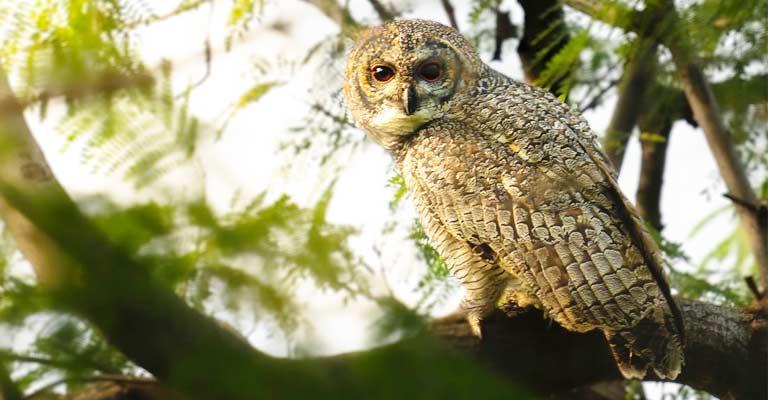
The Mottled Owl (Ciccaba virgata) is distributed across a range of Central and South American countries, primarily inhabiting various forested ecosystems.
Here is a description of its habitat preferences and a general range map based on available information:
Habitat
Mottled Owls display a high degree of habitat adaptability, making them versatile in their choice of dwelling.
They are commonly found in tropical and subtropical forests, including both lowland rainforests and montane cloud forests. These owls also inhabit wooded areas, often favoring locations near rivers and streams.
Additionally, Mottled Owls can be encountered in plantations and secondary-growth forests, showcasing their ability to adapt to human-altered landscapes.
Their preference for forested habitats is linked to their nocturnal hunting behavior, relying on the cover provided by trees and the abundance of prey within these ecosystems.
The varying altitudes and topographies within their range contribute to the diverse array of habitats that Mottled Owls may call home.
Range Map
The range of the Mottled Owl spans a significant portion of Central and South America. While the species is not found in every country within this region, it is observed in several countries with suitable habitats.
The general range includes parts of Mexico, Guatemala, Honduras, El Salvador, Nicaragua, Costa Rica, Panama, Colombia, Ecuador, Venezuela, Peru, and Bolivia.
A more detailed range map would illustrate specific distribution patterns within these countries, highlighting areas where Mottled Owls are more commonly encountered.
The availability of suitable habitat and prey resources contributes to the distribution of these owls within their range.
It’s important to note that the range of bird species can be dynamic, and influenced by factors such as seasonal variations, climate conditions, and human activities.
Conservation efforts often rely on accurate mapping of a species’ range to implement strategies for protection and management.
For the most current and detailed information on the habitat and range of the Mottled Owl, birdwatchers and researchers should refer to authoritative sources, field guides, and ornithological publications that provide up-to-date data and insights into the distribution and ecology of this intriguing owl species.
Mottled Owl Life History
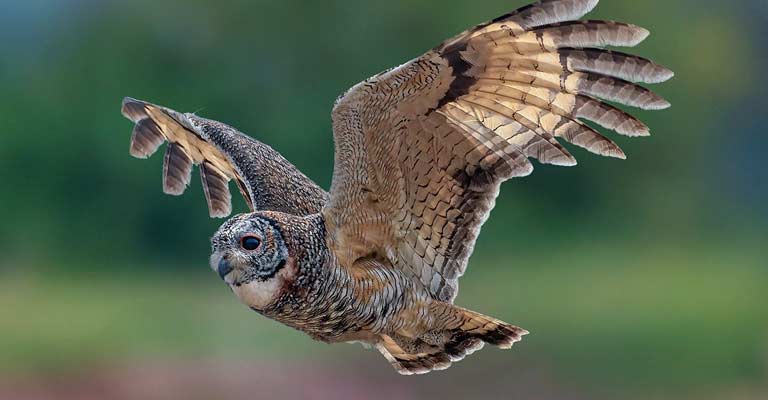
The Mottled Owl (Ciccaba virgata) is a fascinating nocturnal bird species inhabiting the diverse ecosystems of Central and South America.
Its life history unfolds through various stages, each marked by distinctive behaviors and adaptations.
Understanding the intricacies of the Mottled Owl’s life history sheds light on its ecological role and aids in conservation efforts.
Food
Mottled Owls are carnivorous predators, preying primarily on small mammals, birds, insects, and occasionally reptiles. Their nocturnal lifestyle is well-suited for hunting in the cover of darkness.
These owls use their exceptional hearing and keen eyesight to locate prey, employing silent flight to swoop down on unsuspecting victims.
The adaptability of their diet allows them to thrive in a range of habitats, from dense rainforests to open woodlands.
Nesting
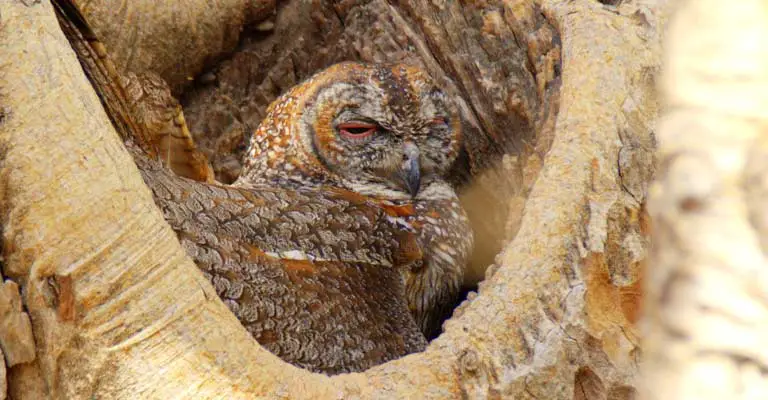
The Mottled Owl exhibits a degree of site fidelity when it comes to nesting.
They typically choose concealed locations within the forest canopy, utilizing tree cavities, abandoned nests of other birds, or natural platforms.
The female Mottled Owl lays a clutch of eggs, and both parents share the responsibility of incubating them.
The nesting period is a critical phase in their life history, as the success of reproduction contributes to the perpetuation of the species.
Here’s a table summarizing the nesting details of the Mottled Owl (Ciccaba virgata):
| Nesting Details | Facts |
| Clutch Size | 2 to 3 eggs |
| Number of Broods | Typically 1 per breeding season |
| Egg Length | Approximately 52-57 mm (2.0-2.2 inches) |
| Egg Width | Approximately 42-44 mm (1.7-1.8 inches) |
| Incubation Period | Around 30 days |
| Nestling Period | Approximately 4 to 5 weeks |
| Egg Description | White, slightly glossy, and spherical or slightly oval-shaped |
| Nest Location | Tree cavities, abandoned nests, natural platforms within forested habitats |
| Nest Composition | Sticks, leaves, and feathers lined with finer materials like fur or down |
| Parental Involvement | Both parents contribute to the incubation and care of the nestlings |
| Nest Protection | Adults may display aggressive behaviors to defend the nest from potential threats |
These nesting details provide insights into the reproductive behavior of the Mottled Owl, highlighting their preferences for nesting sites, parental care, and the developmental stages of their offspring.
Breeding
Breeding behaviors in Mottled Owls are often marked by vocalizations, with individuals engaging in hooting and whistling to communicate with potential mates.
Breeding pairs establish territories, and courtship displays involve mutual preening and aerial acrobatics.
The timing of breeding varies within their range, often corresponding to seasonal changes and the availability of prey.
Mottled Owls are known for their dedicated parenting, with both parents participating in feeding and protecting their offspring.
Diseases
Like many bird species, Mottled Owls can be susceptible to various diseases, including avian pox, aspergillosis, and parasites. These health challenges may impact their overall fitness and reproductive success.
Monitoring the health of wild populations is essential for understanding disease dynamics and implementing measures to mitigate potential threats.
Treatment
Conservationists and wildlife veterinarians play a crucial role in treating and preventing diseases in Mottled Owls.
Treatment strategies may include rehabilitation and release programs for injured or sick individuals, along with habitat management to reduce disease vectors.
Research on the health of Mottled Owl populations contributes to the development of effective treatment protocols and preventive measures.
Conservation
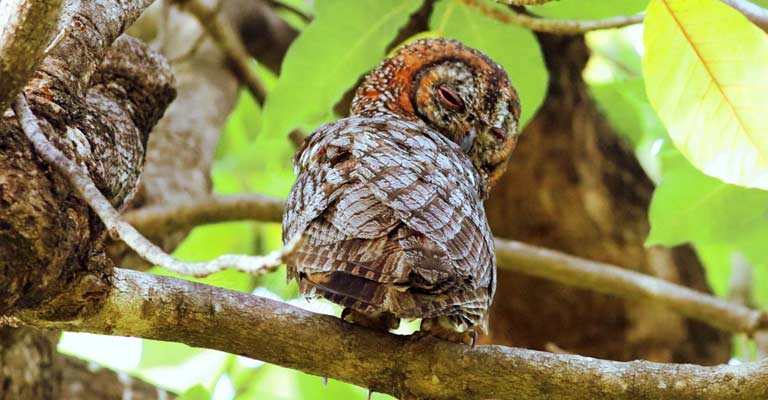
Conservation efforts for Mottled Owls encompass habitat protection, education, and research.
Deforestation, urbanization, and climate change pose threats to their habitats, emphasizing the importance of preserving and restoring critical ecosystems.
Conservation initiatives also involve community engagement to promote sustainable practices and reduce human-wildlife conflicts.
The life history of the Mottled Owl is a tapestry woven with elements of predation, reproduction, health challenges, and conservation imperatives.
Through a comprehensive understanding of these aspects, conservationists and enthusiasts alike can contribute to the preservation of this enigmatic species and the ecosystems it inhabits.
10 Amazing Facts About Mottled Owl
The Mottled Owl (Ciccaba virgata) stands as a captivating and enigmatic nocturnal creature, weaving its way through the dense forests of Central and South America.
Beyond its cryptic appearance and haunting calls, the Mottled Owl conceals a world of intriguing facts that showcase its remarkable adaptations and behaviors.
- Cryptic Plumage: The Mottled Owl earns its name from the intricate patterns adorning its plumage. A mix of rich chocolate-brown, white, and buff spots creates a cryptic appearance, providing camouflage amidst the shadows of its forested habitats.
- Nocturnal Hunter: As a skilled nocturnal hunter, the Mottled Owl employs its keen senses to locate prey in the darkness. Its silent flight, facilitated by specialized feathers, allows it to approach potential meals with stealth and precision.
- Adaptable Diet: Mottled Owls exhibit dietary versatility, preying on small mammals, birds, insects, and occasionally reptiles. This adaptability enables them to thrive in a range of habitats, from dense rainforests to open woodlands.
- Facial Disc and Hearing: The owl’s facial disc, a hallmark of owl species, aids in sound localization. Dark eyes within this disc contribute to its intense gaze, enhancing its ability to detect subtle sounds and movements in the dark.
- Unique Vocalizations: Mottled Owls communicate through a distinctive repertoire of hoots and whistles. These vocalizations play a crucial role in courtship displays, territorial communication, and coordination between mating pairs.
- Territorial Behavior: During the breeding season, Mottled Owls establish territories marked by vocalizations and aerial displays. Courtship involves mutual preening and other bonding behaviors, showcasing the strong connection between breeding pairs.
- Nesting in Concealed Locations: Mottled Owls choose concealed nesting sites within the forest canopy, utilizing tree cavities, abandoned nests, or natural platforms. This preference contributes to the protection of their eggs and nestlings from potential predators.
- Parental Dedication: Both male and female Mottled Owls actively participate in incubating the eggs and caring for the nestlings. This shared parental responsibility reflects a dedication to the well-being and survival of their offspring.
- Silent Flight Adaptations: Specialized wing and feather structures contribute to the Mottled Owl’s silent flight, reducing the sound generated during wingbeats. This adaptation enhances its hunting efficiency, allowing it to approach prey without detection.
- Conservation Concerns: While not currently classified as endangered, the Mottled Owl faces threats from habitat loss due to deforestation and urbanization. Conservation efforts are crucial to preserving the diverse ecosystems that these remarkable owls call home.
The Mottled Owl’s allure extends beyond its aesthetically pleasing appearance, revealing a wealth of adaptations and behaviors that make it a truly remarkable species in the avian world.
Wrapping Up
In the shadowy realms of Central and South American forests, the Mottled Owl emerges as a mystical creature, weaving silent tales of nocturnal prowess, adaptable survival, and dedicated parenthood.
Its cryptic plumage, unique vocalizations, and silent flight echo the enchantment of the avian world.
From concealed nests to the challenges of conservation, the Mottled Owl’s journey reflects a delicate balance in the ecosystems it inhabits.
As we delve into the life history and unravel its secrets, the Mottled Owl stands not just as a bird of the night but as a testament to the wonders of nature and the importance of preserving its intricate tapestry. Thank you so much.